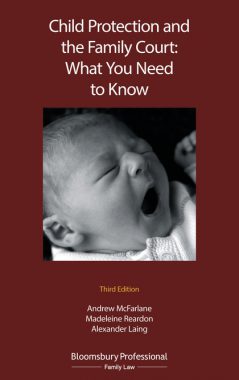Albert Einstein is reputed to have said that if you can’t explain something simply, you don’t understand it well enough.
GPs are specifically named as part of the target audience of this book, written by three eminent lawyers. In the information-replete world of medicine, and the time constraints that GPs must work by, any legal textbook needs to be relevant and understandable without recourse to a legal degree as a Rosetta Stone.
Child protection is irrefutably relevant – the Family Court has at least a potential bearing on any consultation involving children. Therefore, it’s very welcome to see a book comprehensible to those of us who are GPs, not lawyers.
The authors avoid legalese, choosing rather to employ simple English, with clear explanations of key legislation and procedure.
The text is friendly to the eye; paragraphs are sequentially-enumerated, ensuring that any cross referencing isn’t tedious; and salient information is highlighted. There are also several informative case studies to focus attention on important topics or dilemmas.
As GPs, we encounter many situations involving children, in which there are no immediately apparent correct responses. For instance, if faced with an access to information request about a child from one parent who’s in disagreement with the other, the GP will be well served to refer to Chapter Three, which deals with parental responsibility and when parents are in dispute.
It has the right amount of information for GPs with or without a specific child safeguarding role
For GPs who aren’t sure if the actions of a parent are putting a child at risk, there’s an explanation of the concept of harm ‘attributable to parental care’, and the standard expected of a reasonable parent, which social services would most likely employ in their decision-making.
This will be useful for GPs to understand concepts such as significant harm or aspects of child protection plans when communicating with social services.
As well as this, there’s a description of the different ways a child at risk may come to the attention of social services, and what the local authority’s response might be. This will prove invaluable to GPs who aren’t sure what the local authority’s responsibilities are once a notification is made. There’s a clear discussion of the three main areas that a local authority will focus on: the child’s developmental needs; the parenting capacity of anyone with primary responsibility for the child’s care; and the relevant family and environmental factors.
The book offers explanations of Section 17 or Section 47 assessments, the timescales for those assessments to be undertaken, and, importantly for GPs, what information the local authority is likely to seek. The book describes situations in which the Family Court might become involved and what the court would expect of professionals or agencies involved in the child’s care.
As such, the book helps GPs to better understand their role within the ambit of the wider professional community in this area.
For GPs who are interested in judicial rulings, Chapter 10 discusses the Family Court’s inherent jurisdiction, while sections of several important cases are contained in Appendix 6. The latter will be especially pleasing to GPs who wish to see extracts from important judgments and understand how important concepts, such as parental responsibility, are described in judicial rulings.
The authors state that the ‘law can only function effectively if it is readily understood by all who have to use it’. Their book satisfies the Einsteinian equation, explaining child protection and family courts simply enough for those who’ve never formally trained in law. The only contention that I’d make is that Mrs Gillick had five daughters, not four as suggested on Page 27, at the time of the High Court ruling.
It may be a moot point – I humbly submit the BBC story from the time.
Overall, ‘Child Protection and the Family Court: What you need to know’ is a jargon-free, well-structured book that appears to have the right amount of information for GPs, with or without a specific child safeguarding role, for reference in their day-to-day role. It might also serve as a Rosetta Stone for GPs wanting to look at more specialist legal resources or considering an interest in medical law.
Dr Sanjeewa Sumathipala is a GP in Gloucestershire
Child Protection and the Family Court: What you need to know is published by Bloomsbury Professional.
Please get in touch with Pulse if you’re interested in reviewing other titles relevant to GPs
Pulse October survey
Take our July 2025 survey to potentially win £1.000 worth of tokens













